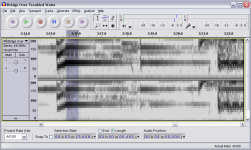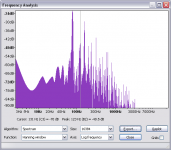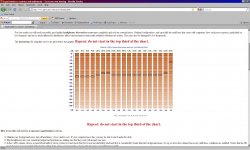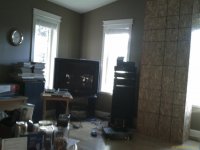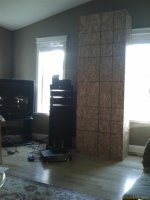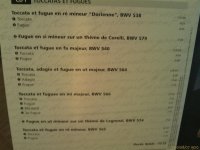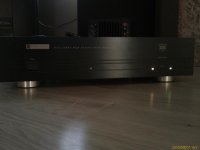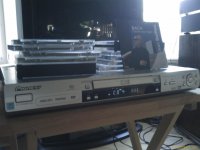QUOTE=wtaylorbasil
Hi Don Hill. Many thanks for the help but I am unable to get results yet. Please see below.
1. Downlosded Audacity 1.2.6
2. File does not give "Import" option. File, open and loaded a wav track
3. File preferences, FFT size 4096, tick grey scale & max frequency 200. No min frequency, gain, range or frequency gain options available
Then your steps 4 not available and hence sub step 1 to 3 unable to do.
Where Am I going wrong
William
It's my fault, I should have specified that I'm using 1.3.9 (beta).
It's available here:
Download Audacity from SourceForge.net
On earlier versions, the Import option was on a different tab. They also did not allow setting the frequency range of the spectrogram.
In many cases, the "beta" version of a product is best avoided as it may be slow (debugging code) and crash-prone. But in my experience the beta versions of Audacity are reliable. The "beta" designation is there mainly because features and UI design may change without notice.
I notice the latest beta is 1.3.12 - when I have time, I'll try it out.
CD List with Low Musical Notes
Cool, thanks for the listing on those low tone CD's. to quote "Remind me again why anybody _wants_ vinyl." I first heard P&F in C min by JSB in 1961 on the FM radio, bought the vinyl LP, became a real fan. Finally found a 25 pedal organ I can afford 49 years later. Wow, that 32' bass on the Hammond H100 is amazing. Played the LP again after I learned 2 pages of the piece on the Hammond, even with 15" woofers in the SP2 speakers the Hammond has the LP beat for shaking the viscera. But it all started by hearing the LP over a tinny little 5" table radio speaker.
The Hammond H100 came with a "free" P40 "tone cabinet" which has another 15" speaker in a box 48" tall ported at the top. I haven't hooked it up, I'm afraid of the 120VAC run in the rubber 9 pin cord. Forty year old rubber is dirt. But I wonder if Hammond knew something about making a subwoofer. It has it's own transistor amp that is transformer coupled (the last of a long line of interstage transformers), I haven't bothered to recap it yet until I figure out how to sanely power it and interface it.
wtaylorbasil said:Hi Indianajones,
You mention "the listing on those low tone CD's". I went through the thread and did not find any listing of CDs-it would be great to have the list amalgamated in one thread if there are many contributors. Would you direct me to the Posting or Thresd please.
Regards
William
computer use
There are various CD titles listed in this thread. Copy and paste the interesting posts to a text file. The CD's have colored text in most cases, or a cover picture. Right click the picture or CD name, pick "copy link location", paste the location next to the title or picture in you text file. You will have to cut and paste the holtz album cover image separately to your text directory. There. Some CD's the title only was listed. Purchase information is available for most CD's on Amazon.com or through google to vendors on other continents or vendors with different terms or stock. Good luck.
There are various CD titles listed in this thread. Copy and paste the interesting posts to a text file. The CD's have colored text in most cases, or a cover picture. Right click the picture or CD name, pick "copy link location", paste the location next to the title or picture in you text file. You will have to cut and paste the holtz album cover image separately to your text directory. There. Some CD's the title only was listed. Purchase information is available for most CD's on Amazon.com or through google to vendors on other continents or vendors with different terms or stock. Good luck.
Back to the chat about what is on recordings, I've reported some SPL and bottom-end Hz-stuff for the Toronto Samba Squad (both live at an open-air festival two blocks from home and on CD) as well as everybody's hero, Gustavo Dudamel and the H.I.S. Orchestra* (that's an old Stokowski joke).
Here
*Simon Bolivar Absolutely Incredible Youth Band
Here
*Simon Bolivar Absolutely Incredible Youth Band
Last edited:
Low frequency identification
It's my fault, I should have specified that I'm using 1.3.9 (beta).
It's available here:
Download Audacity from SourceForge.net
On earlier versions, the Import option was on a different tab. They also did not allow setting the frequency range of the spectrogram.
In many cases, the "beta" version of a product is best avoided as it may be slow (debugging code) and crash-prone. But in my experience the beta versions of Audacity are reliable. The "beta" designation is there mainly because features and UI design may change without notice.
I notice the latest beta is 1.3.12 - when I have time, I'll try it out.[/QUOTE
Hi,
DON HILLS. I have managed to get an image of track "Bridge Over Troubled Waters" by Simon & Garfunkel around 3min 15 sec from start and I can see 30Hz @-63dB, 60hz @ -49dB and another 80Hz @ -35dB. But how do I know which one is the note I hear-probably a bass guitar? I don't know how to upload the snapshot so you could walk me through. Or perhaps if you have the track, would you look at it and explain to me? At -63 db can that 30Hz note be heard?
Regards
William
snip I have managed to get an image of track "Bridge Over Troubled Waters" by Simon & Garfunkel around 3min 15 sec from start and I can see 30Hz @-63dB, 60hz @ -49dB and another 80Hz @ -35dB. But how do I know which one is the note I hear-probably a bass guitar? I don't know how to upload the snapshot so you could walk me through. Or perhaps if you have the track, would you look at it and explain to me? At -63 db can that 30Hz note be heard?
Regards
William
With a real-time spectrum analyzer (like the limb-along but free MacCRO X or Windows equivalent), you just play the music, set the chart to 10-110 Hz, 2.6 Hz sampling, and watch the dancing line on the screen. Clear as day.
Ask Google for freeware oscilloscope.
Hi,
DON HILLS. I have managed to get an image of track "Bridge Over Troubled Waters" by Simon & Garfunkel around 3min 15 sec from start and I can see 30Hz @-63dB, 60hz @ -49dB and another 80Hz @ -35dB. But how do I know which one is the note I hear-probably a bass guitar? I don't know how to upload the snapshot so you could walk me through. Or perhaps if you have the track, would you look at it and explain to me? At -63 db can that 30Hz note be heard?
Regards
William
William,
I assume you mean the section where the bass comes in just after 3min 15 sec. It slides up to a long, repeated note just before the verse begins "Sail on silver bird...". It's a 78 hz note, with a second harmonic about 6 db lower.
On my version, it peaks about 24 dB below full scale, although the whole track is low level and peaks about - 6dB at the final crescendo. It was ripped from an old CD, not a "remaster" which are often compressed to make the levels higher.
See the attached images.
The first one is the relevant section of the track, starting with the piano, followed by the bass notes, and the verse coming in at the right.
The section of bass "highlighted" (shaded in darker grey) in the display is analysed and displayed in the second image. You can see the very sharp peak at 78 Hz and the second harmonic at about 155 Hz, with additional harmonics above that.
Regards...
Attachments
snip
I'm not sure what else might be on recordings but the Widor note is about the lowest I know of, pending checking through my collection a bit.
snip
I've been watching my recordings.
post #40.
About the Murray/Ruffatti recording, yes some 20 Hz stuff. Dunno if it is just limitations of my system, but some profound bass runs aren't the lowest. In Band 1, 20 Hz shows up a few times (3:02, 3:30, 4:50-end). Some 18 Hz in Band 8 near end. On Band 8, some 15 Hz around 3:15.
The Telarc/Cincinatti 1812 may be a "digital cannon" and mostly 32 Hz (same as the big side drum there) but also rumblings down to 10.
The Kodo Drummers ("Heartbeat of Drummers of Japan") has a band called "Big Drum." Loud and resonant but no content below 43.
I'm thinking about sub'ing my Klipsch in order to bring up the 18-40 octave. Not much content down there, but.... Anybody think I should?
Bridge Over Troubled Waters
William,
I assume you mean the section where the bass comes in just after 3min 15 sec. It slides up to a long, repeated note just before the verse begins "Sail on silver bird...". It's a 78 hz note, with a second harmonic about 6 db lower.
On my version, it peaks about 24 dB below full scale, although the whole track is low level and peaks about - 6dB at the final crescendo. It was ripped from an old CD, not a "remaster" which are often compressed to make the levels higher.
See the attached images.
The first one is the relevant section of the track, starting with the piano, followed by the bass notes, and the verse coming in at the right.
The section of bass "highlighted" (shaded in darker grey) in the display is analysed and displayed in the second image. You can see the very sharp peak at 78 Hz and the second harmonic at about 155 Hz, with additional harmonics above that.
Regards...
wtaylorbasil said:So what are the 3Hz, 10Hz, 30Hz and 40 Hz heavy shaded ones on the left of the 78Hz you mention? I have not yet grasped the skill of interpriting the trace so please bear with me.
Regards
William
wtaylorbasil said:So what are the 3Hz, 10Hz, 30Hz and 40 Hz heavy shaded ones on the left of the 78Hz you mention? I have not yet grasped the skill of interpriting the trace so please bear with me.
Regards
William
They could be caused by any of the following:
- Environmental sound in the original recording studio (traffic, air conditioning etc)
- Noise in the recording system (desk, tape deck etc)
- Artifacts from the encoding process (my source was an MP3)
Notes:
- You will not hear them due to the high level of the rest of the music. For example, due to the effects of the "equal loudness" response of the human ear, the 30 Hz tone would need to be over 12 dB louder than the 78 Hz tone to be subjectively as loud. Instead, it is over 40 dB quieter.
- The 30 Hz tone, and others, are present throughout the song and not just in the one place. This means that they are from a source not related to the music, such as air conditioning noise. If you look at the start of the track, the 30 Hz tone is not present for the first second or two, but fades up after a few seconds. This implies it is being picked up by a microphone that is being faded up after the beginning of the track.
- There is a relatively high level of very low frequency (about 0 Hz). The analysis has response right down to DC, and will show any DC offset in the original signal. I'll need to compare the CD with the MP3 to see if it was present in the CD or was introduced by the MP3 encoding process.
- The 30 Hz peak shows as a broad, rounded hump rather than a sharp peak like the 78 Hz note. this means that the 30 Hz signal is actually a band of noise centred around 30 Hz, rather than a pure tone. To see what a real 30 Hz tone looks like in the display, do the following:
1. Tracks --> Add New --> Audio Track
2. Generate --> Tone
3. Waveform: Sine, Frequency: 30, amplitude: 1, duration: 30 seconds.
4. Select a couple of seconds of the tone from the display.
5. Analyse --> Plot Spectrum.
Notice that the peak is much sharper than the one on the S&G track.
It's not needle sharp, and there is a LF tail, because of the finite bandwidth of the analyser. Making the analysis window wider would sharpen it, but 16384 is the largest window in Audacity. There are other programs which offer wider windows.
You may notice that the spectrogram display of the track section that I attached does not show the 30 Hz band. I found that by reducing the dynamic range of the display, small artifacts are not shown. Edit --> Preferences --> Spectrogram --> Range: 40 dB (default was 80 dB).
Thus, only sounds that are likely to be audible are shown.
Some day...these will be mine 
http://www.passdiy.com/pdf/el-pipe-o.pdf
Now that there's a lot more long-stroke 21" drivers available, should kick some serious butt...
http://www.passdiy.com/pdf/el-pipe-o.pdf
Now that there's a lot more long-stroke 21" drivers available, should kick some serious butt...
Sound Wave Analysis
They could be caused by any of the following:
- Environmental sound in the original recording studio (traffic, air conditioning etc)
- Noise in the recording system (desk, tape deck etc)
- Artifacts from the encoding process (my source was an MP3)
Notes:
- You will not hear them due to the high level of the rest of the music. For example, due to the effects of the "equal loudness" response of the human ear, the 30 Hz tone would need to be over 12 dB louder than the 78 Hz tone to be subjectively as loud. Instead, it is over 40 dB quieter.
- The 30 Hz tone, and others, are present throughout the song and not just in the one place. This means that they are from a source not related to the music, such as air conditioning noise. If you look at the start of the track, the 30 Hz tone is not present for the first second or two, but fades up after a few seconds. This implies it is being picked up by a microphone that is being faded up after the beginning of the track.
- There is a relatively high level of very low frequency (about 0 Hz). The analysis has response right down to DC, and will show any DC offset in the original signal. I'll need to compare the CD with the MP3 to see if it was present in the CD or was introduced by the MP3 encoding process.
- The 30 Hz peak shows as a broad, rounded hump rather than a sharp peak like the 78 Hz note. this means that the 30 Hz signal is actually a band of noise centred around 30 Hz, rather than a pure tone. To see what a real 30 Hz tone looks like in the display, do the following:
1. Tracks --> Add New --> Audio Track
2. Generate --> Tone
3. Waveform: Sine, Frequency: 30, amplitude: 1, duration: 30 seconds.
4. Select a couple of seconds of the tone from the display.
5. Analyse --> Plot Spectrum.
Notice that the peak is much sharper than the one on the S&G track.
It's not needle sharp, and there is a LF tail, because of the finite bandwidth of the analyser. Making the analysis window wider would sharpen it, but 16384 is the largest window in Audacity. There are other programs which offer wider windows.
You may notice that the spectrogram display of the track section that I attached does not show the 30 Hz band. I found that by reducing the dynamic range of the display, small artifacts are not shown. Edit --> Preferences --> Spectrogram --> Range: 40 dB (default was 80 dB).
Thus, only sounds that are likely to be audible are shown.
wtaylorbasil said:Thank you for your patience. I am beginning to make some sense of it all. I managed to capture three snapshots and I can say that the oscilloscope one is more precise in pin-pointing the fundamental. The Overtone is quite good but the band is quite wide and the curser could be more left (and lower frequency) or more right and higher frequency. Please have a look at the attachments and comment on them. I hope I can upload the attachments.
Regards
William
PS Overtone did not load.
Attachments
William,
The oscilloscope display does illustrate the fundamental and harmonics quite well. I do have a couple of comments: First, note that the display is "jagged". That is, there are relatively few sample points across the display. This implies a relatively low resolution - there may be narrow peaks that are missed because they don't correspond to a frequency where a level measurement was made. Second, the display is in linear frequency mode. Setting it to "log" mode, if possible, would expand the range from 0 to 100 Hz or so which is the area of interest in this case. It would occupy more of the screen instead of being squashed into the left hand side.
I notice you put your screen shots into Word documents. That can make it difficult for people with non-Microsoft systems to see them. It's just as easy to make "proper" images of them, using just the standard system tools:
1. Click on the window of interest, to make sure it has the "focus".
2. Press Alt-PrintScreen. This should capture the current window to the clipboard.
3. Open Paint (usually Start --> Accessories --> Paint).
4. Paste (Ctrl-V) the clipboard image into Paint.
5. Edit (crop or resize) if required.
6. File --> Save As... and name it. Select the "Save as type..." to suit the image being saved. PNG is good for graphic-type screen shots like the oscilloscope. JPG is often better for photographs or any image with smooth color graduations.
Regards,
Don.
The oscilloscope display does illustrate the fundamental and harmonics quite well. I do have a couple of comments: First, note that the display is "jagged". That is, there are relatively few sample points across the display. This implies a relatively low resolution - there may be narrow peaks that are missed because they don't correspond to a frequency where a level measurement was made. Second, the display is in linear frequency mode. Setting it to "log" mode, if possible, would expand the range from 0 to 100 Hz or so which is the area of interest in this case. It would occupy more of the screen instead of being squashed into the left hand side.
I notice you put your screen shots into Word documents. That can make it difficult for people with non-Microsoft systems to see them. It's just as easy to make "proper" images of them, using just the standard system tools:
1. Click on the window of interest, to make sure it has the "focus".
2. Press Alt-PrintScreen. This should capture the current window to the clipboard.
3. Open Paint (usually Start --> Accessories --> Paint).
4. Paste (Ctrl-V) the clipboard image into Paint.
5. Edit (crop or resize) if required.
6. File --> Save As... and name it. Select the "Save as type..." to suit the image being saved. PNG is good for graphic-type screen shots like the oscilloscope. JPG is often better for photographs or any image with smooth color graduations.
Regards,
Don.
snp
I haven't hooked it up, I'm afraid of the 120VAC run in the rubber 9 pin cord. Forty year old rubber is dirt.snip
Familiar with ArmorAll over in the automobile department at Walmart? Great spritzer for adding life and liveliness to rubber stuff.*
For old electric cords, it can bring back the dead.
*I am sure somebody will post that it is just a combination of kerosene and lanolin or maybe WD40 and cottage cheese or something. Might well be and wish I knew how to make it. Works great but a no-no on bike tires.
I just came off of a listening session with the FLH horn. I was listening to Jean Guillou's Pictures at an Exhibition on Dorian. I almost fell off of my chair! There is a 53 db dynamic range from the quietest track ( 3 ) to the loudest tracks ( 14,15) Bass peaked out at about 104 db. That's measured on my old Rat shack meter. Decently accurate once you get the calibration curve worked in.
I set the level so that on track three the swell box used by Guillou which is fully closed is audible but not very loud. A level that I have heard many times in person on different organs. So from that quiet little track to the full roar of them there pipes is something to listen to.
I'm going to go and check out John Balka's Vierne's Wesminster chimes and see what's what with that CD. It's fun when all are gone. I can shake ratttle and roll with impunity!
Mark
I set the level so that on track three the swell box used by Guillou which is fully closed is audible but not very loud. A level that I have heard many times in person on different organs. So from that quiet little track to the full roar of them there pipes is something to listen to.
I'm going to go and check out John Balka's Vierne's Wesminster chimes and see what's what with that CD. It's fun when all are gone. I can shake ratttle and roll with impunity!
Mark
I forgot to post this link for checking your hearing.
It's pretty cool. I'm reasonably falt until 16khz where I know I'm off the deep end. I'm still good to 14.5 khz but that's not available on this test.
Equal loudness contours and audiometry - Test your own hearing
I present my golden ears as the first submission. At least I think they are golden. Only set I've ever listened to!
Mark
It's pretty cool. I'm reasonably falt until 16khz where I know I'm off the deep end. I'm still good to 14.5 khz but that's not available on this test.
Equal loudness contours and audiometry - Test your own hearing
I present my golden ears as the first submission. At least I think they are golden. Only set I've ever listened to!
Mark
Attachments
Holst the Planets by Peter Sykes on Raven Recordings. I'm still listening to this baby. Saturn started out at 59 db and peaked near the end at 109 db. So still some serious dynamic range. I kept the multimeter at peak hold a peaked out 15.9 volts AC 31.6 watts at peak. I just plugged the numbers into Hornresp at it is spot on for the input level.
Gotta check out some Bach.
Mark
Gotta check out some Bach.
Mark
A bit oh show and tell.
The make shift setup. It works. The speakers are ones I made when I was 13. I'll admit to my Dad helping me away back then. They have been updated quite a bit since then. Actually completely. But the cabinets are original. The monolith is the FLH TRIO12. It is firing up towards the ceiling about 3 feet away from it. I've been suffering listening to Bach by Guillou. I will enjoy this evening to be sure.
One thing that is most interesting as a decending scale is being played on the pipe organ there is a slight loss in SPL. But it is not as much as one might think. Going down an octave on the last part of Bach Piece d'Orgue the level drops by about 10 db but stays rather constant in the last notes of the octave. With a good subwoofer you get the rise and droop of the bass wave. And it has texture that is rather intoxicating. No one note bass but palpable differences in tone colour. Anyway back to some more Bach. I think I go from Paris to Saint-Maximin la Sainte Baume to listen to Bcch on a nasty french clasical organ.http://www.google.ca/url?sa=t&sourc...sg=AFQjCNHzuS54SapWVYJgkD9TpuDIRpt_dQ&cad=rja
Mark
The make shift setup. It works. The speakers are ones I made when I was 13. I'll admit to my Dad helping me away back then. They have been updated quite a bit since then. Actually completely. But the cabinets are original. The monolith is the FLH TRIO12. It is firing up towards the ceiling about 3 feet away from it. I've been suffering listening to Bach by Guillou. I will enjoy this evening to be sure.
One thing that is most interesting as a decending scale is being played on the pipe organ there is a slight loss in SPL. But it is not as much as one might think. Going down an octave on the last part of Bach Piece d'Orgue the level drops by about 10 db but stays rather constant in the last notes of the octave. With a good subwoofer you get the rise and droop of the bass wave. And it has texture that is rather intoxicating. No one note bass but palpable differences in tone colour. Anyway back to some more Bach. I think I go from Paris to Saint-Maximin la Sainte Baume to listen to Bcch on a nasty french clasical organ.http://www.google.ca/url?sa=t&sourc...sg=AFQjCNHzuS54SapWVYJgkD9TpuDIRpt_dQ&cad=rja
Mark
Attachments
Last edited:
- Status
- This old topic is closed. If you want to reopen this topic, contact a moderator using the "Report Post" button.
- Home
- Loudspeakers
- Subwoofers
- Ruffatti Organ is on pitch: 32.72 Hz
